engine BMW X3 2006 E83 Service and warranty information
[x] Cancel search | Manufacturer: BMW, Model Year: 2006, Model line: X3, Model: BMW X3 2006 E83Pages: 53, PDF Size: 7.15 MB
Page 3 of 53
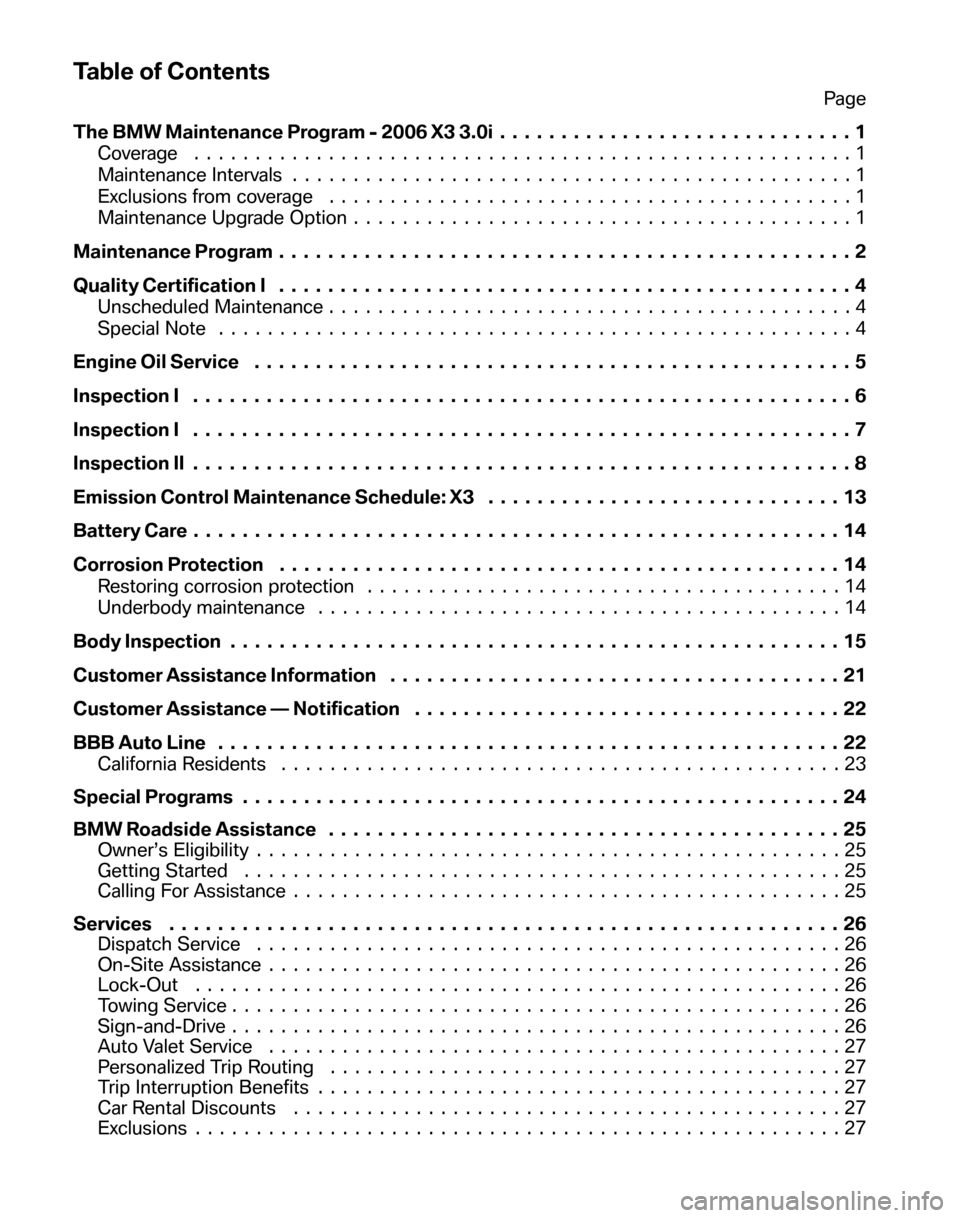
Table of Contents
Page
The BMW Maintenance Program - 2006 X3 3.0i . . . ..........................1
Coverage ......................................................1
Maintenance Intervals ..............................................1
Exclusions from coverage ...........................................1
Maintenance Upgrade Option .........................................1
Maintenance Program ...............................................2
Quality Certification I ...............................................4
Unscheduled Maintenance ...........................................4
Special Note ....................................................4
Engine Oil Service .................................................5
Inspection I ......................................................6
Inspection I ......................................................7
Inspection II ......................................................8
Emission Control Maintenance Schedule: X3 . . ...........................13
BatteryCare.....................................................14
Corrosion Protection ..............................................14
Restoring corrosion protection .......................................14
Underbody maintenance ...........................................14
Body Inspection . . . ...............................................15
Customer Assistance Information .....................................21
Customer Assistance — Notification ...................................22
BBB Auto Line . . . ................................................22
California Residents ..............................................23
Special Programs .................................................24
BMW Roadside Assistance ..........................................25
Owner’s Eligibility ................................................25
Getting Started .................................................25
Calling For Assistance .............................................25
Services . ......................................................26
Dispatch Service ................................................26
On-Site Assistance ...............................................26
Lock-Out .....................................................26
Towing Service ..................................................26
Sign-and-Drive ..................................................26
Auto Valet Service ...............................................27
Personalized Trip Routing ..........................................27
Trip Interruption Benefits ...........................................27
Car Rental Discounts .............................................27
Exclusions .....................................................27
Page 6 of 53
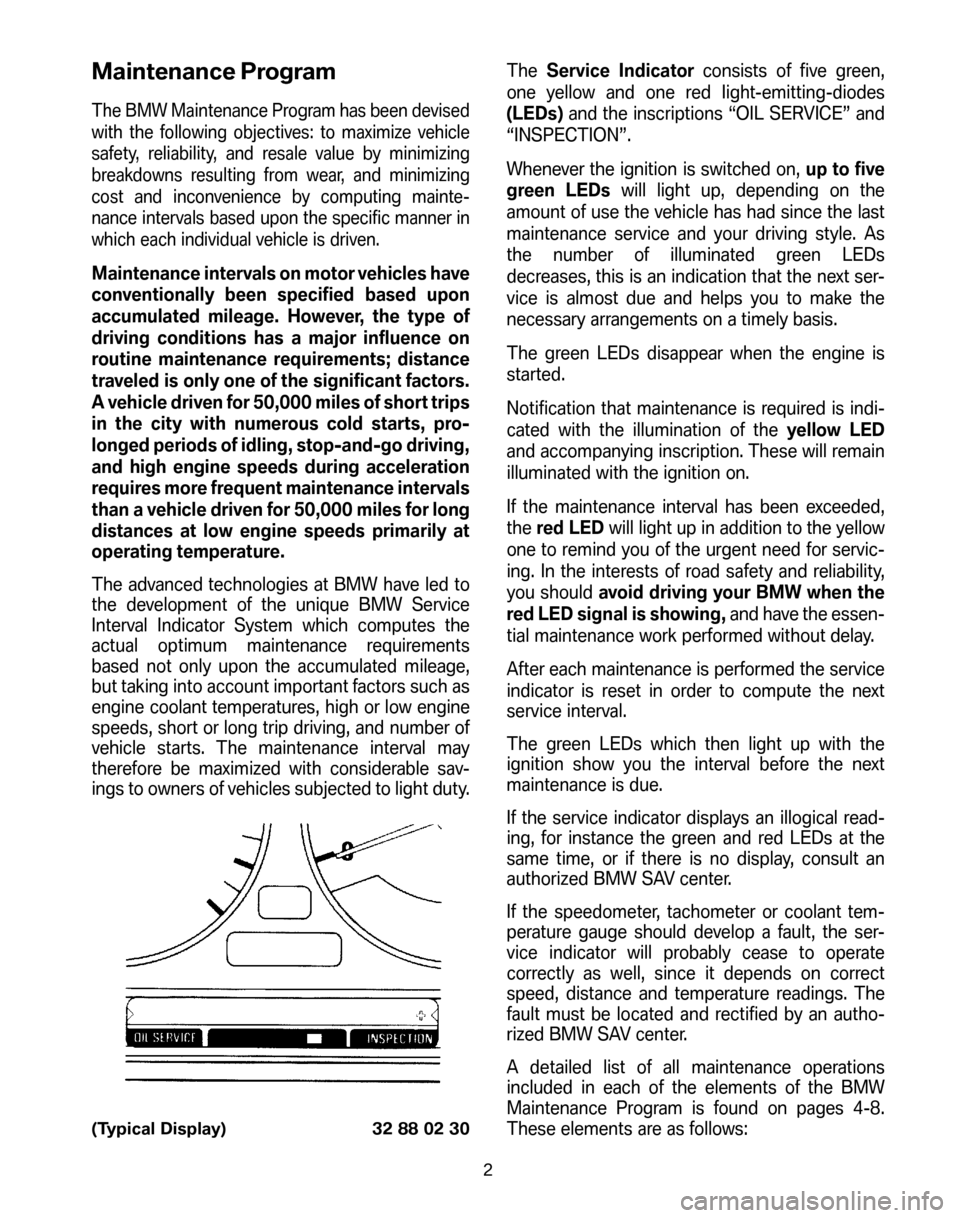
Maintenance Program
The BMW Maintenance Program has been devised
with the following objectives: to maximize vehicle
safety, reliability, and resale value by minimizing
breakdowns resulting from wear, and minimizing
cost and inconvenience by computing mainte-
nance intervals based upon the specific manner in
which each individual vehicle is driven.
Maintenance intervals on motor vehicles have
conventionally been specified based upon
accumulated mileage. However, the type of
driving conditions has a major influence on
routine maintenance requirements; distance
traveled is only one of the significant factors.
A vehicle driven for 50,000 miles of short trips
in the city with numerous cold starts, pro-
longed periods of idling, stop-and-go driving,
and high engine speeds during acceleration
requires more frequent maintenance intervals
than a vehicle driven for 50,000 miles for long
distances at low engine speeds primarily at
operating temperature.
The advanced technologies at BMW have led to
the development of the unique BMW Service
Interval Indicator System which computes the
actual optimum maintenance requirements
based not only upon the accumulated mileage,
but taking into account important factors such as
engine coolant temperatures, high or low engine
speeds, short or long trip driving, and number of
vehicle starts. The maintenance interval may
therefore be maximized with considerable sav-
ings to owners of vehicles subjected to light duty. The
Service Indicator consists of five green,
one yellow and one red Iight-emitting-diodes
(LEDs) and the inscriptions “OIL SERVICE” and
“INSPECTION”.
Whenever the ignition is switched on, up to five
green LEDs will light up, depending on the
amount of use the vehicle has had since the last
maintenance service and your driving style. As
the number of illuminated green LEDs
decreases, this is an indication that the next ser-
vice is almost due and helps you to make the
necessary arrangements on a timely basis.
The green LEDs disappear when the engine is
started.
Notification that maintenance is required is indi-
cated with the illumination of the yellow LED
and accompanying inscription. These will remain
illuminated with the ignition on.
If the maintenance interval has been exceeded,
the red LED will light up in addition to the yellow
one to remind you of the urgent need for servic-
ing. In the interests of road safety and reliability,
you should avoid driving your BMW when the
red LED signal is showing, and have the essen-
tial maintenance work performed without delay.
After each maintenance is performed the service
indicator is reset in order to compute the next
service interval.
The green LEDs which then light up with the
ignition show you the interval before the next
maintenance is due.
If the service indicator displays an illogical read-
ing, for instance the green and red LEDs at the
same time, or if there is no display, consult an
authorized BMW SAV center.
If the speedometer, tachometer or coolant tem-
perature gauge should develop a fault, the ser-
vice indicator will probably cease to operate
correctly as well, since it depends on correct
speed, distance and temperature readings. The
fault must be located and rectified by an autho-
rized BMW SAV center.
A detailed list of all maintenance operations
included in each of the elements of the BMW
Maintenance Program is found on pages 4-8.
These elements are as follows:
(Typical Display) 32 88 02 30
2
Page 7 of 53
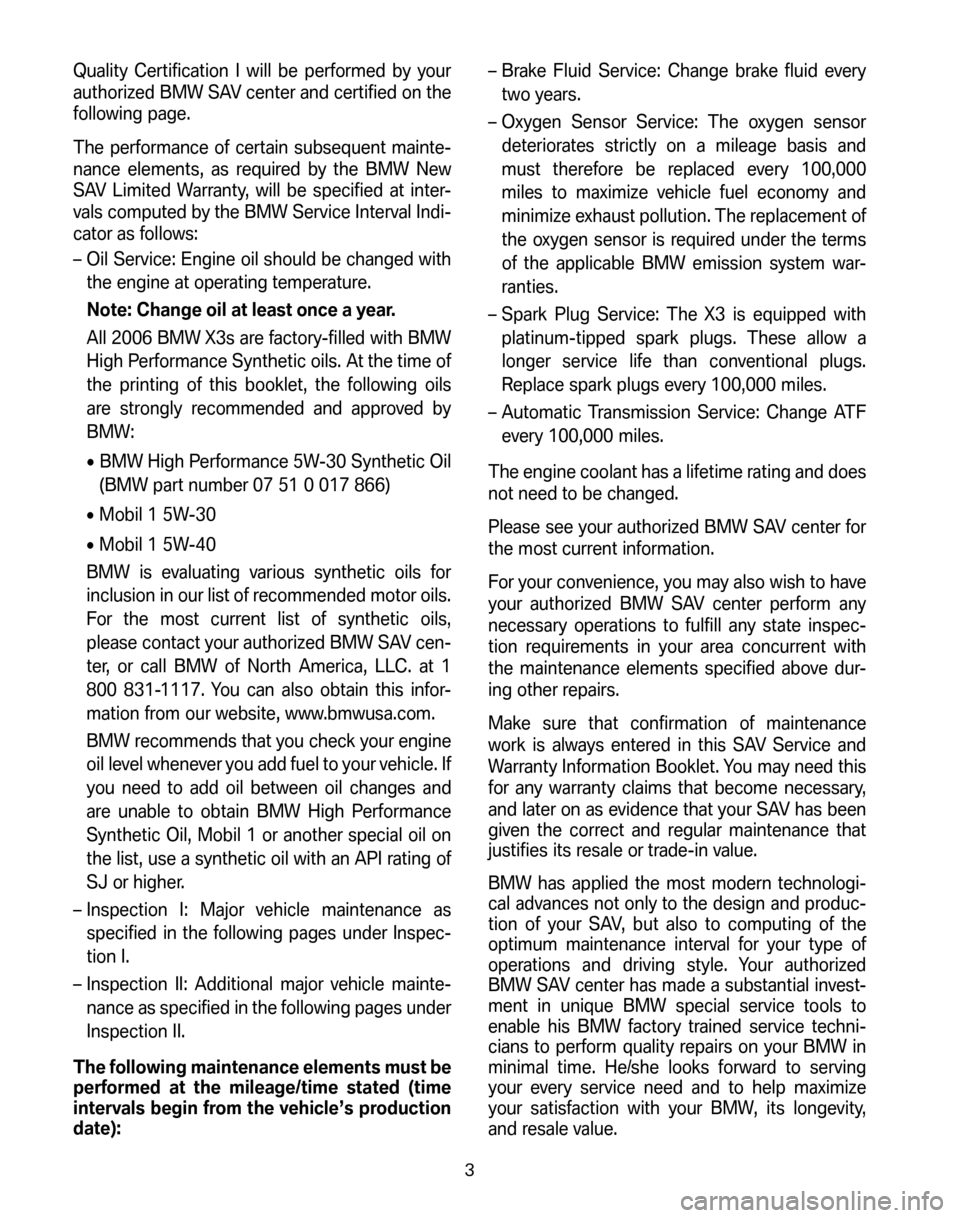
Quality Certification I will be performed by your
authorized BMW SAV center and certified on the
following page.
The performance of certain subsequent mainte-
nance elements, as required by the BMW New
SAV Limited Warranty, will be specified at inter-
vals computed by the BMW Service Interval Indi-
cator as follows:
– Oil Service: Engine oil should be changed with the engine at operating temperature.
Note: Change oil at least once a year.
All 2006 BMW X3s are factory-filled with BMW
High Performance Synthetic oils. At the time of
the printing of this booklet, the following oils
are strongly recommended and approved by
BMW:
• BMW High Performance 5W-30 Synthetic Oil
(BMW part number 07 51 0 017 866)
• Mobil 1 5W-30
• Mobil 1 5W-40
BMW is evaluating various synthetic oils for
inclusion in our list of recommended motor oils.
For the most current list of synthetic oils,
please contact your authorized BMW SAV cen-
ter, or call BMW of North America, LLC. at 1
800 831-1117. You can also obtain this infor-
mation from our website, www.bmwusa.com.
BMW recommends that you check your engine
oil level whenever you add fuel to your vehicle. If
you need to add oil between oil changes and
are unable to obtain BMW High Performance
Synthetic Oil, Mobil 1 or another special oil on
the list, use a synthetic oil with an API rating of
SJ or higher.
– Inspection I: Major vehicle maintenance as specified in the following pages under Inspec-
tion I.
– Inspection II: Additional major vehicle mainte- nance as specified in the following pages under
Inspection II.
The following maintenance elements must be
performed at the mileage/time stated (time
intervals begin from the vehicle’s production
date): – Brake Fluid Service: Change brake fluid every
two years.
– Oxygen Sensor Service: The oxygen sensor deteriorates strictly on a mileage basis and
must therefore be replaced every 100,000
miles to maximize vehicle fuel economy and
minimize exhaust pollution. The replacement of
the oxygen sensor is required under the terms
of the applicable BMW emission system war-
ranties.
– Spark Plug Service: The X3 is equipped with platinum-tipped spark plugs. These allow a
longer service life than conventional plugs.
Replace spark plugs every 100,000 miles.
– Automatic Transmission Service: Change ATF every 100,000 miles.
The engine coolant has a lifetime rating and does
not need to be changed.
Please see your authorized BMW SAV center for
the most current information.
For your convenience, you may also wish to have
your authorized BMW SAV center perform any
necessary operations to fulfill any state inspec-
tion requirements in your area concurrent with
the maintenance elements specified above dur-
ing other repairs.
Make sure that confirmation of maintenance
work is always entered in this SAV Service and
Warranty Information Booklet. You may need this
for any warranty claims that become necessary,
and later on as evidence that your SAV has been
given the correct and regular maintenance that
justifies its resale or trade-in value.
BMW has applied the most modern technologi-
cal advances not only to the design and produc-
tion of your SAV, but also to computing of the
optimum maintenance interval for your type of
operations and driving style. Your authorized
BMW SAV center has made a substantial invest-
ment in unique BMW special service tools to
enable his BMW factory trained service techni-
cians to perform quality repairs on your BMW in
minimal time. He/she looks forward to serving
your every service need and to help maximize
your satisfaction with your BMW, its longevity,
and resale value.
3
Page 8 of 53
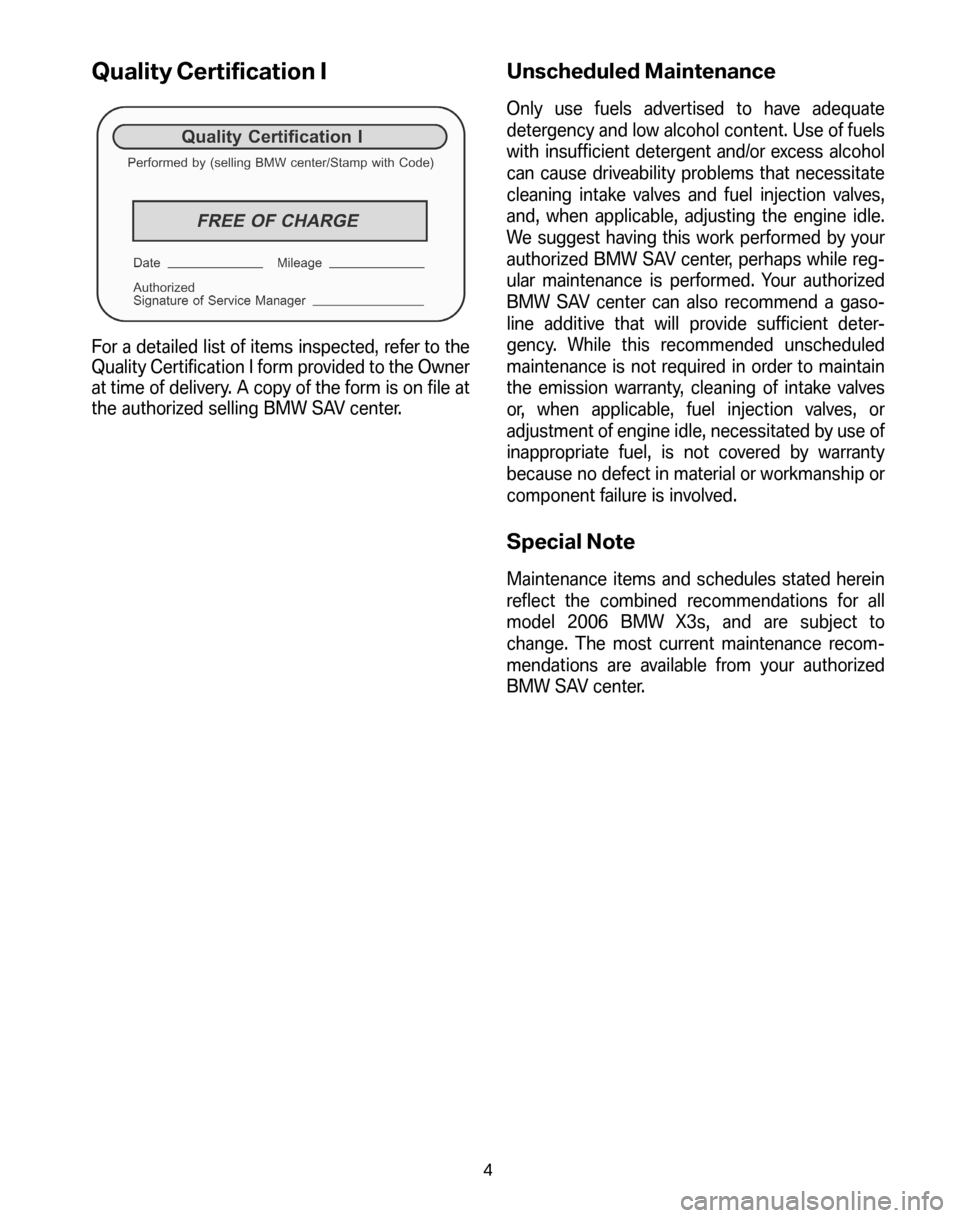
Quality Certification I
For a detailed list of items inspected, refer to the
Quality Certification I form provided to the Owner
at time of delivery. A copy of the form is on file at
the authorized selling BMW SAV center.
Unscheduled Maintenance
Only use fuels advertised to have adequate
detergency and low alcohol content. Use of fuels
with insufficient detergent and/or excess alcohol
can cause driveability problems that necessitate
cleaning intake valves and fuel injection valves,
and, when applicable, adjusting the engine idle.
We suggest having this work performed by your
authorized BMW SAV center, perhaps while reg-
ular maintenance is performed. Your authorized
BMW SAV center can also recommend a gaso-
line additive that will provide sufficient deter-
gency. While this recommended unscheduled
maintenance is not required in order to maintain
the emission warranty, cleaning of intake valves
or, when applicable, fuel injection valves, or
adjustment of engine idle, necessitated by use of
inappropriate fuel, is not covered by warranty
because no defect in material or workmanship or
component failure is involved.
Special Note
Maintenance items and schedules stated herein
reflect the combined recommendations for all
model 2006 BMW X3s, and are subject to
change. The most current maintenance recom-
mendations are available from your authorized
BMW SAV center.
4
Page 9 of 53
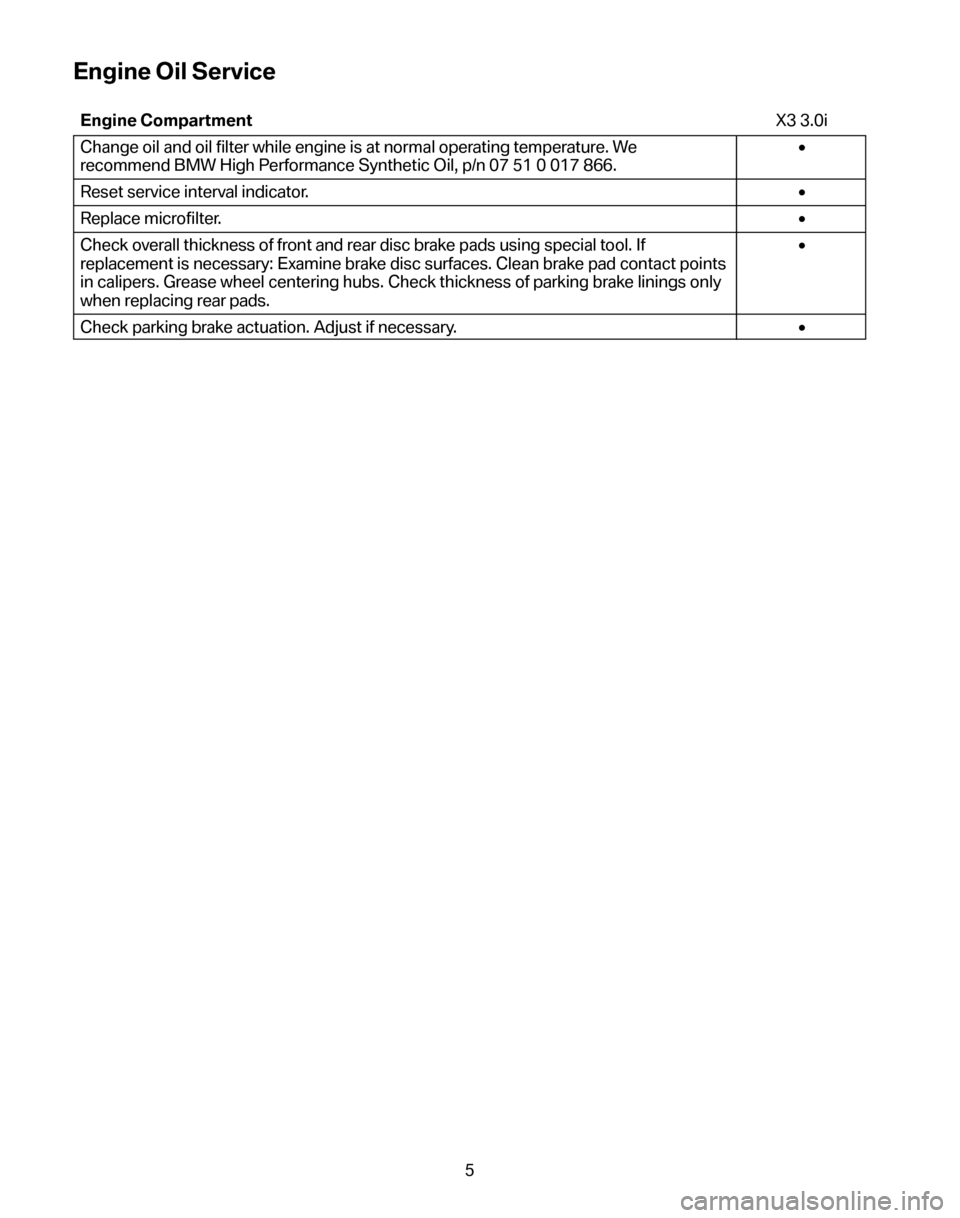
Engine Oil Service
Engine CompartmentX3 3.0i
Change oil and oil filter while engine is at normal operating temperature. We
recommend BMW High Performance Synthetic Oil, p/n 07 51 0 017 866. •
Reset service interval indicator. •
Replace microfilter. •
Check overall thickness of front and rear disc brake pads using special tool. If
replacement is necessary: Examine brake disc surfaces. Clean brake pad contact points
in calipers. Grease wheel centering hubs. Check thickness of parking brake linings only
when replacing rear pads. •
Check parking brake actuation. Adjust if necessary. •
5
Page 10 of 53
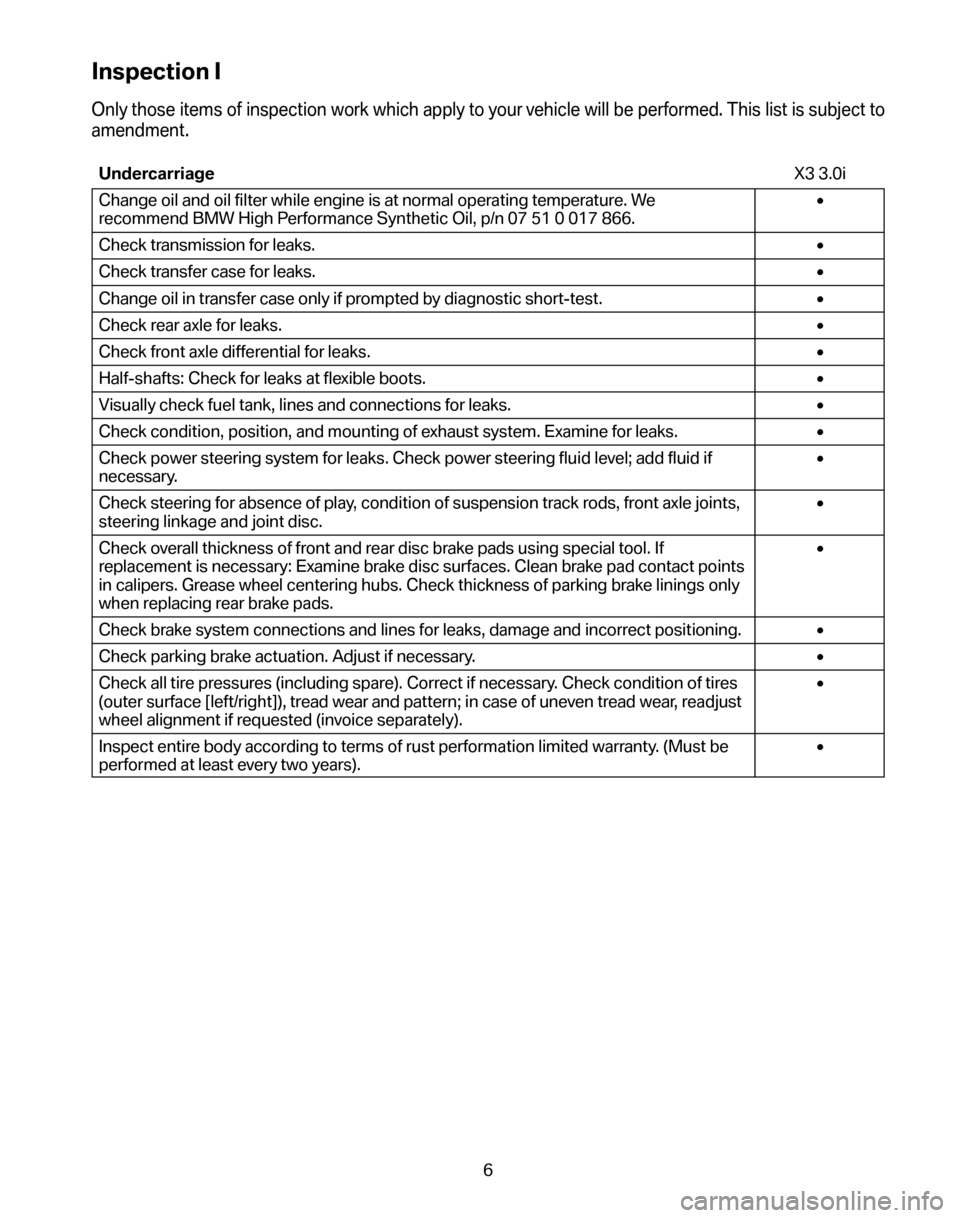
Inspection I
Only those items of inspection work which apply to your vehicle will be performed. This list is subject to
amendment.
Undercarriage X3 3.0i
Change oil and oil filter while engine is at normal operating temperature. We
recommend BMW High Performance Synthetic Oil, p/n 07 51 0 017 866. •
Check transmission for leaks. •
Check transfer case for leaks. •
Change oil in transfer case only if prompted by diagnostic short-test. •
Check rear axle for leaks. •
Check front axle differential for leaks. •
Half-shafts: Check for leaks at flexible boots. •
Visually check fuel tank, lines and connections for leaks. •
Check condition, position, and mounting of exhaust system. Examine for leaks. •
Check power steering system for leaks. Check power steering fluid level; add fluid if
necessary. •
Check steering for absence of play, condition of suspension track rods, front axle joints,
steering linkage and joint disc. •
Check overall thickness of front and rear disc brake pads using special tool. If
replacement is necessary: Examine brake disc surfaces. Clean brake pad contact points
in calipers. Grease wheel centering hubs. Check thickness of parking brake linings only
when replacing rear brake pads. •
Check brake system connections and lines for leaks, damage and incorrect positioning. •
Check parking brake actuation. Adjust if necessary. •
Check all tire pressures (including spare). Correct if necessary. Check condition of tires
(outer surface [left/right]), tread wear and pattern; in case of uneven tread wear, readjust
wheel alignment if requested (invoice separately). •
Inspect entire body according to terms of rust performation limited warranty. (Must be
performed at least every two years). •
6
Page 11 of 53
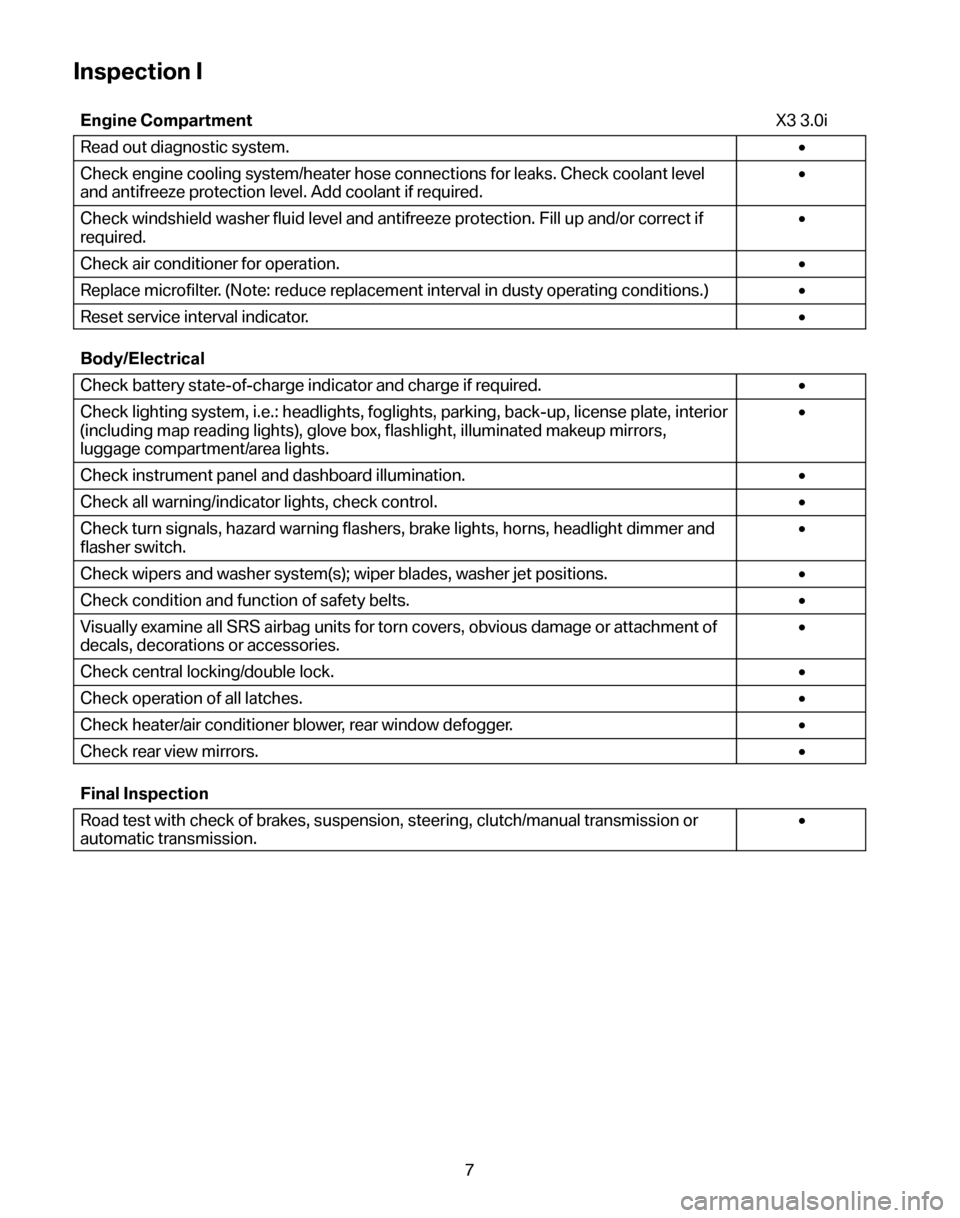
Inspection I
Engine CompartmentX3 3.0i
Read out diagnostic system. •
Check engine cooling system/heater hose connections for leaks. Check coolant level
and antifreeze protection level. Add coolant if required. •
Check windshield washer fluid level and antifreeze protection. Fill up and/or correct if
required. •
Check air conditioner for operation. •
Replace microfilter. (Note: reduce replacement interval in dusty operating conditions.) •
Reset service interval indicator. •
Body/Electrical
Check battery state-of-charge indicator and charge if required. •
Check lighting system, i.e.: headlights, foglights, parking, back-up, license plate, interior
(including map reading lights), glove box, flashlight, illuminated makeup mirrors,
luggage compartment/area lights. •
Check instrument panel and dashboard illumination. •
Check all warning/indicator lights, check control. •
Check turn signals, hazard warning flashers, brake lights, horns, headlight dimmer and
flasher switch. •
Check wipers and washer system(s); wiper blades, washer jet positions. •
Check condition and function of safety belts. •
Visually examine all SRS airbag units for torn covers, obvious damage or attachment of
decals, decorations or accessories. •
Check central locking/double lock. •
Check operation of all latches. •
Check heater/air conditioner blower, rear window defogger. •
Check rear view mirrors. •
Final Inspection
Road test with check of brakes, suspension, steering, clutch/manual transmission or
automatic transmission. •
7
Page 12 of 53
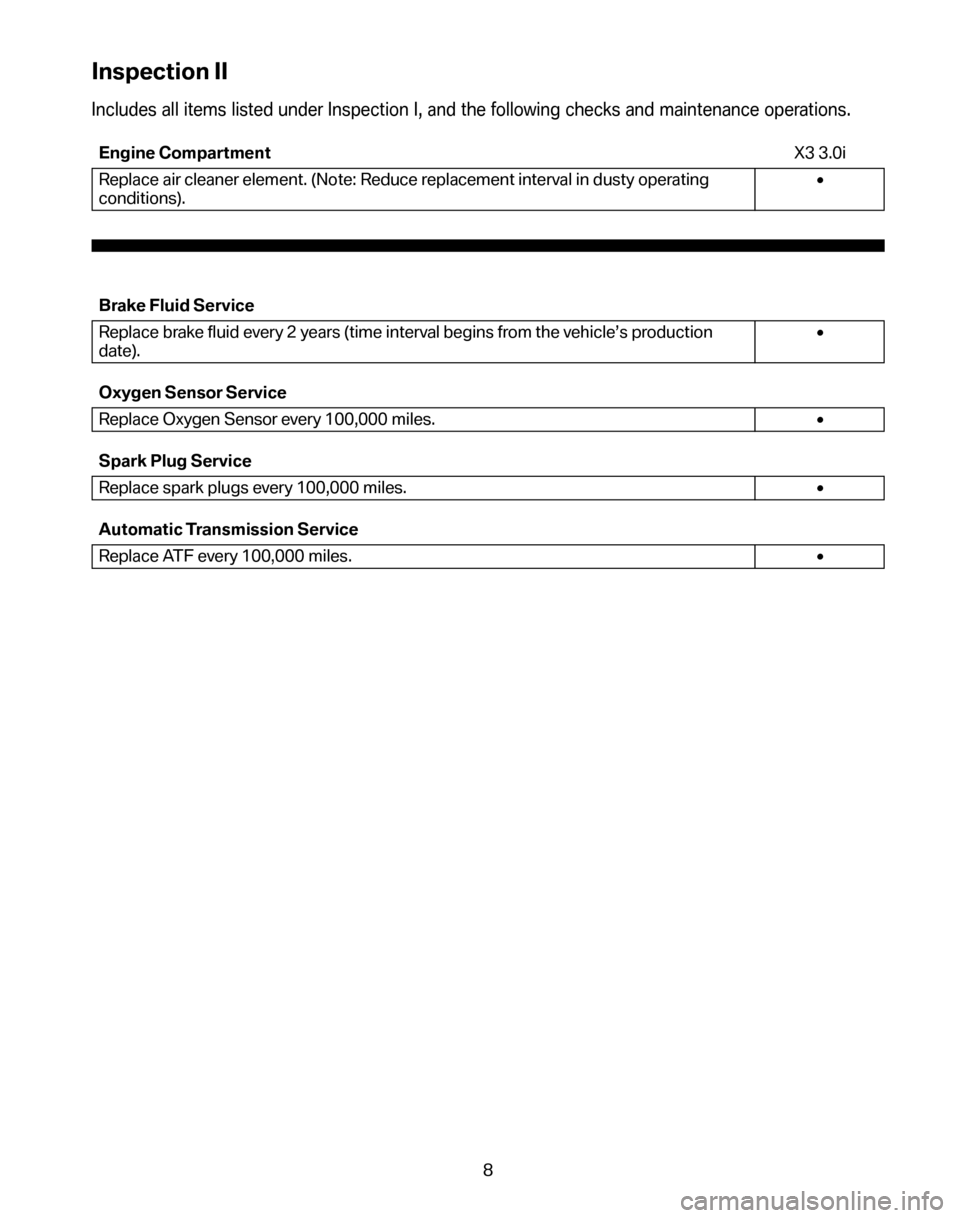
Inspection II
Includes all items listed under Inspection I, and the following checks and maintenance operations.
Engine CompartmentX3 3.0i
Replace air cleaner element. (Note: Reduce replacement interval in dusty operating
conditions). •
Brake Fluid Service
Replace brake fluid every 2 years (time interval begins from the vehicle’s production
date). •
Oxygen Sensor Service
Replace Oxygen Sensor every 100,000 miles.
•
Spark Plug Service
Replace spark plugs every 100,000 miles. •
Automatic Transmission Service
Replace ATF every 100,000 miles. •
8
Page 17 of 53
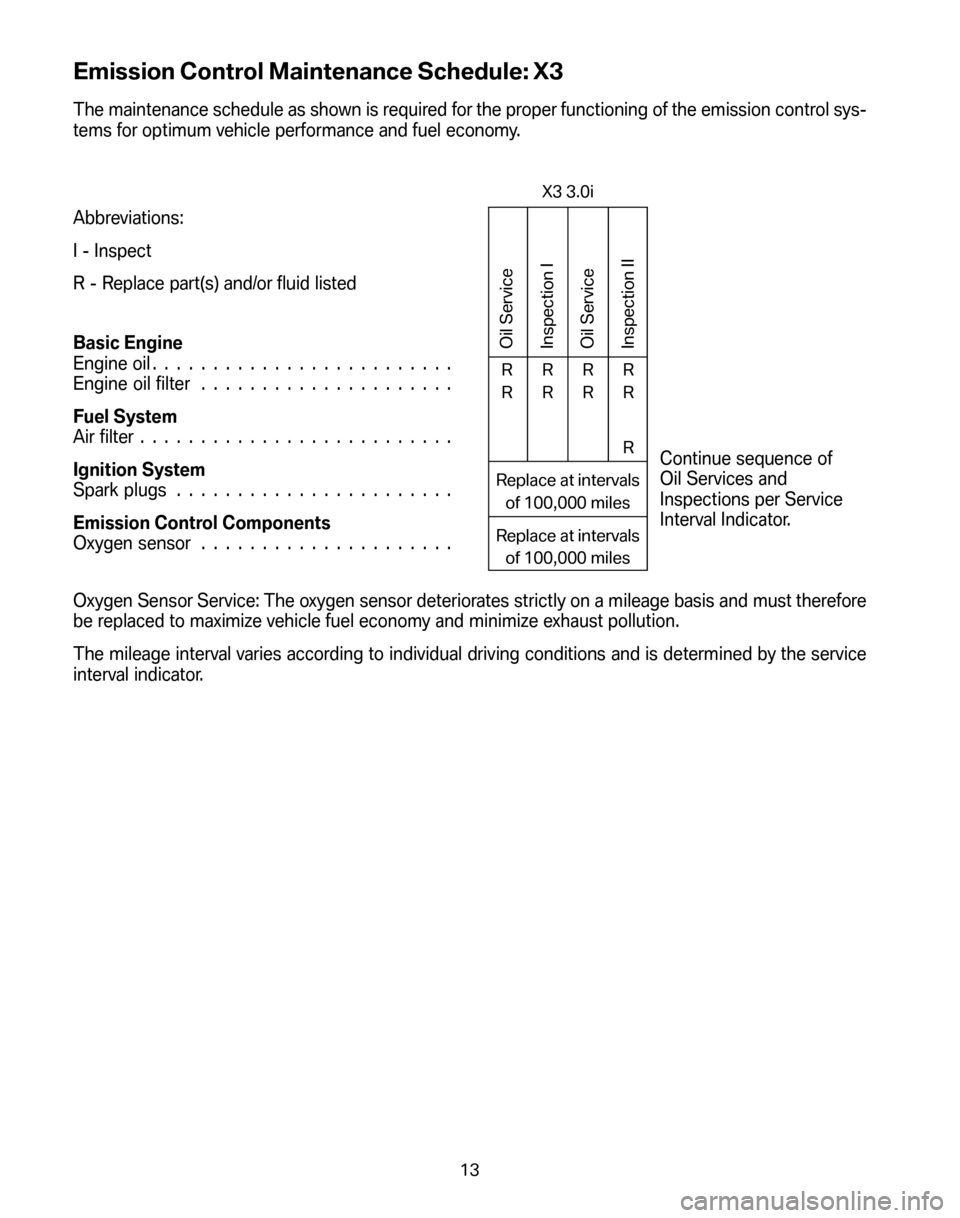
Emission Control Maintenance Schedule: X3
The maintenance schedule as shown is required for the proper functioning of the emission control sys-
tems for optimum vehicle performance and fuel economy.
Abbreviations:
I - Inspect
R - Replace part(s) and/or fluid listed
Basic Engine
Engine oil .........................
Engine oil filter .....................
Fuel System
Air filter ..........................
Ignition System
Spark plugs .......................
Emission Control Components
Oxygen sensor .....................
X3 3.0i
Oil Service
Inspection I
Oil Service
Inspection II
R
R R
R R
R R
R
R
Replace at intervals of 100,000 miles
Replace at intervals of 100,000 miles
Continue sequence of
Oil Services and
Inspections per Service
Interval Indicator.
Oxygen Sensor Service: The oxygen sensor deteriorates strictly on a mileage basis and must therefore
be replaced to maximize vehicle fuel economy and minimize exhaust pollution.
The mileage interval varies according to individual driving conditions and is determined by the service
interval indicator.
13
Page 18 of 53
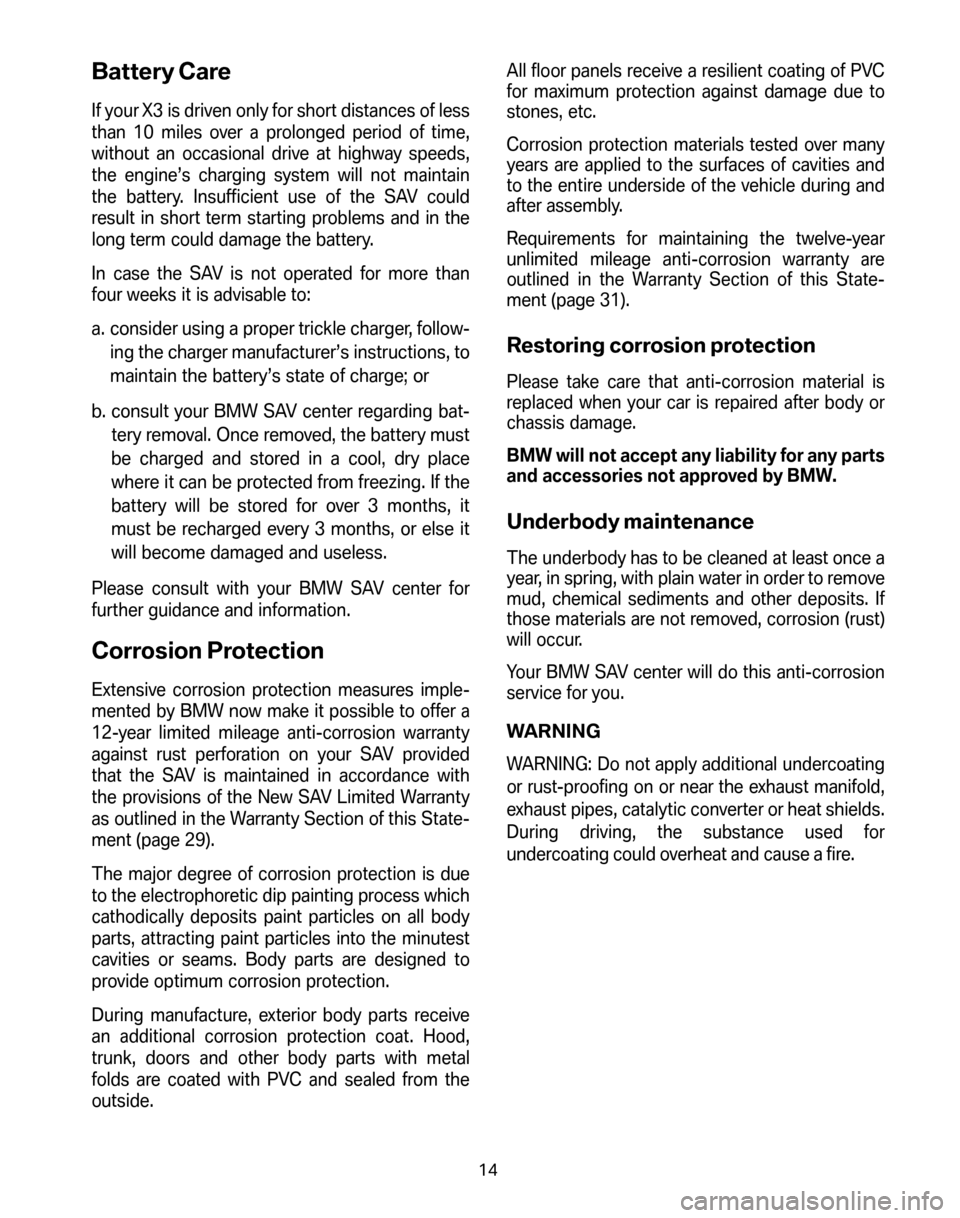
Battery Care
If your X3 is driven only for short distances of less
than 10 miles over a prolonged period of time,
without an occasional drive at highway speeds,
the engine’s charging system will not maintain
the battery. Insufficient use of the SAV could
result in short term starting problems and in the
long term could damage the battery.
In case the SAV is not operated for more than
four weeks it is advisable to:
a. consider using a proper trickle charger, follow- ing the charger manufacturer’s instructions, to
maintain the battery’s state of charge; or
b. consult your BMW SAV center regarding bat- tery removal. Once removed, the battery must
be charged and stored in a cool, dry place
where it can be protected from freezing. If the
battery will be stored for over 3 months, it
must be recharged every 3 months, or else it
will become damaged and useless.
Please consult with your BMW SAV center for
further guidance and information.
Corrosion Protection
Extensive corrosion protection measures imple-
mented by BMW now make it possible to offer a
12-year limited mileage anti-corrosion warranty
against rust perforation on your SAV provided
that the SAV is maintained in accordance with
the provisions of the New SAV Limited Warranty
as outlined in the Warranty Section of this State-
ment (page 29).
The major degree of corrosion protection is due
to the electrophoretic dip painting process which
cathodically deposits paint particles on all body
parts, attracting paint particles into the minutest
cavities or seams. Body parts are designed to
provide optimum corrosion protection.
During manufacture, exterior body parts receive
an additional corrosion protection coat. Hood,
trunk, doors and other body parts with metal
folds are coated with PVC and sealed from the
outside. All floor panels receive a resilient coating of PVC
for maximum protection against damage due to
stones, etc.
Corrosion protection materials tested over many
years are applied to the surfaces of cavities and
to the entire underside of the vehicle during and
after assembly.
Requirements for maintaining the twelve-year
unlimited mileage anti-corrosion warranty are
outlined in the Warranty Section of this State-
ment (page 31).
Restoring corrosion protection
Please take care that anti-corrosion material is
replaced when your car is repaired after body or
chassis damage.
BMW will not accept any liability for any parts
and accessories not approved by BMW.
Underbody maintenance
The underbody has to be cleaned at least once a
year, in spring, with plain water in order to remove
mud, chemical sediments and other deposits. If
those materials are not removed, corrosion (rust)
will occur.
Your BMW SAV center will do this anti-corrosion
service for you.
WARNING
WARNING: Do not apply additional undercoating
or rust-proofing on or near the exhaust manifold,
exhaust pipes, catalytic converter or heat shields.
During driving, the substance used for
undercoating could overheat and cause a fire.
14